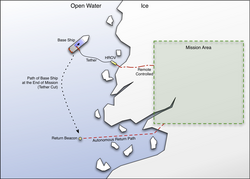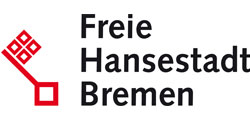HROV-Arch
Control Architecture for an Hybrid-ROV
Dr.-Ing. Sylvain Joyeux
The goal of the HROV-Arch project is the development of control architecture for a hybrid ROV system. The HROV is developed and integrated at the MARUM Bremen and is targeted for oceanographic research. The control architecture should be able to seamlessly switch between remotely operated and full-autonomous control, while keeping the vehicle in a safe state at all times. The architecture will be implemented using ROCK and will be tested on the real vehicle at the end of the project.
| Duration: | 16.08.2011 till 30.09.2013 |
| Donee: | University of Bremen |
| Sponsor: | State of Bremen |
| Partner: | MARUM Bremen |
| Application Field: | Underwater Robotics |
| Related Projects: |
CUSLAM
Localization and mapping in confined underwater environments
(09.2009-
07.2012)
CSurvey
A semi-autonomous inspection unit for underwater structures and ship hulls - subproject of CView compound-project
(05.2009-
04.2012)
iMoby
Intelligent Mobility
(04.2009-
06.2012)
|
Project details
The goal of this project is the software design of the control architecture of the HROV (Hybrid Remotely Operated Vehicle) system. This project is the initial project of the MarTech virtual institute (a collaboration of MARUM, DLR-RY and AG Robotik/DFKI RIC). The operative goal of the HROV is the operation under ice, where the system is controlled by a human operator via a fiberglass link most of the time, and switched to full autonomy when contact is lost on accident or the vehicle has to return to the mother vessel. The HROV system is designed and integrated by MARUM, the control architecture concepts and the framework are developed by DFKI RIC.
Designing the control system of a hybrid ROV/AUV is a challenge. Such a system has to be able to switch between human control, to a complete autonomous recover mission within instant. This implies thoroughly designed multi-mode control architecture with a reliable and adaptive fault detection and fault response system.
The primary goals for DFKI RIC are:
Development of a Multi-Mode Control Architecture: The architecture must be a mixture between reactive execution, interactive task execution and execution of pre-defined mission plans. It is absolutely mandatory that at any time a control task is active, which keeps the HROV in a safe mode of operation while performing. The case of the vehicle being dead in the water has to be avoided under all circumstances. The basic idea, which will be used to solve this problem, is by using a component-based approach with a top-down specification and a bottom-up implementation.
Development of Fault-Detection and Fault-Response System: For the operation of an AUV as well as a ROV fault detection and fault response systems (FDFRS) is an absolute necessity. In the case of HROV, this system is even more important: the loss of communication via the fiberglass in ROV mode has to be detected, and the HROV must return to its mother ship by itself in a safe manner. Considering the loss of communication during an operation under ice, this return system can be quite complex. It is planned to design a hierarchical FDFRS, which is tightly integrated into the control architecture.
Extension of ROCK: The robot construction toolkit (ROCK), designed by DFKI RIC, is the base system for the implementation of the HROV control architecture. Within the HROV project ROCK will be extended by drivers for typical maritime sensors and actors (DVL, side-scan sonar etc.) and hardened for long term autonomy and control.


